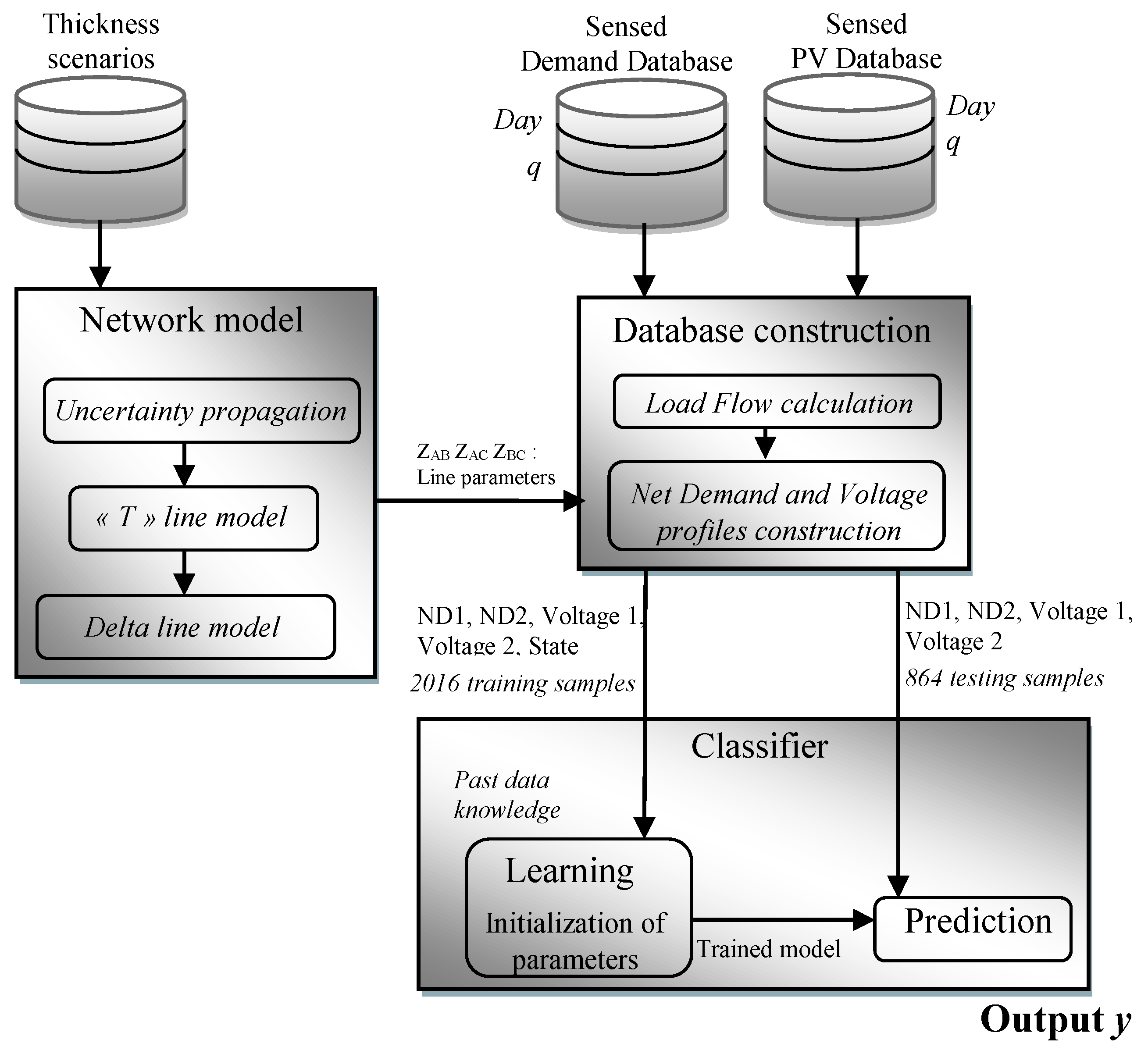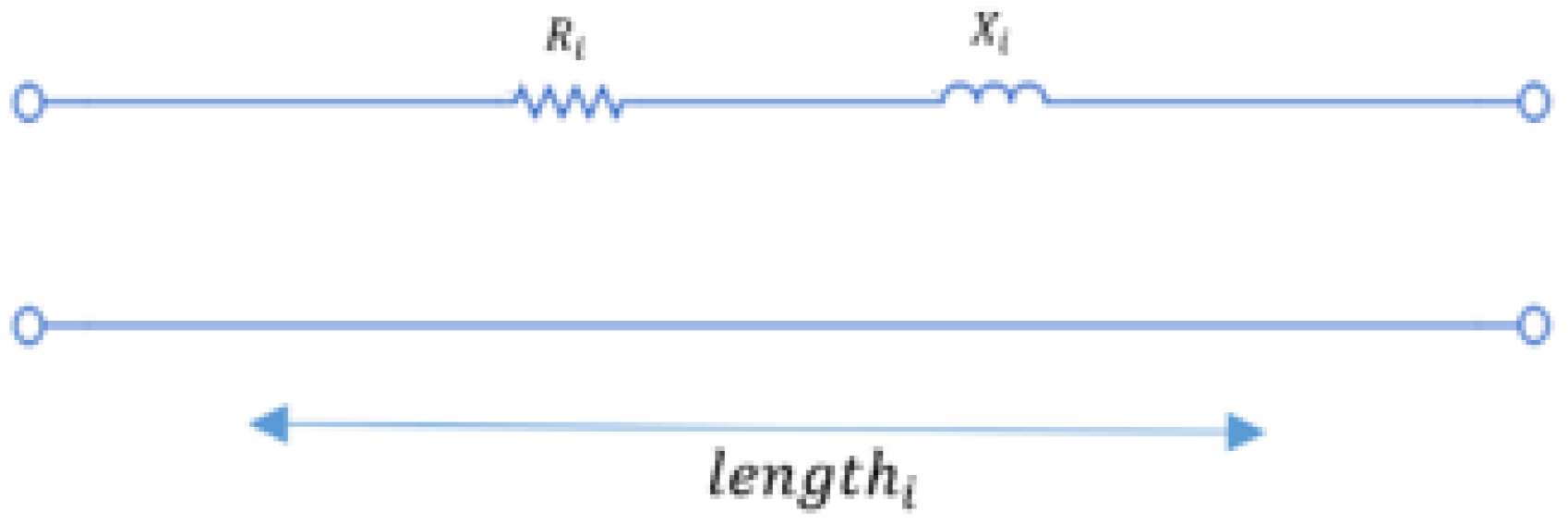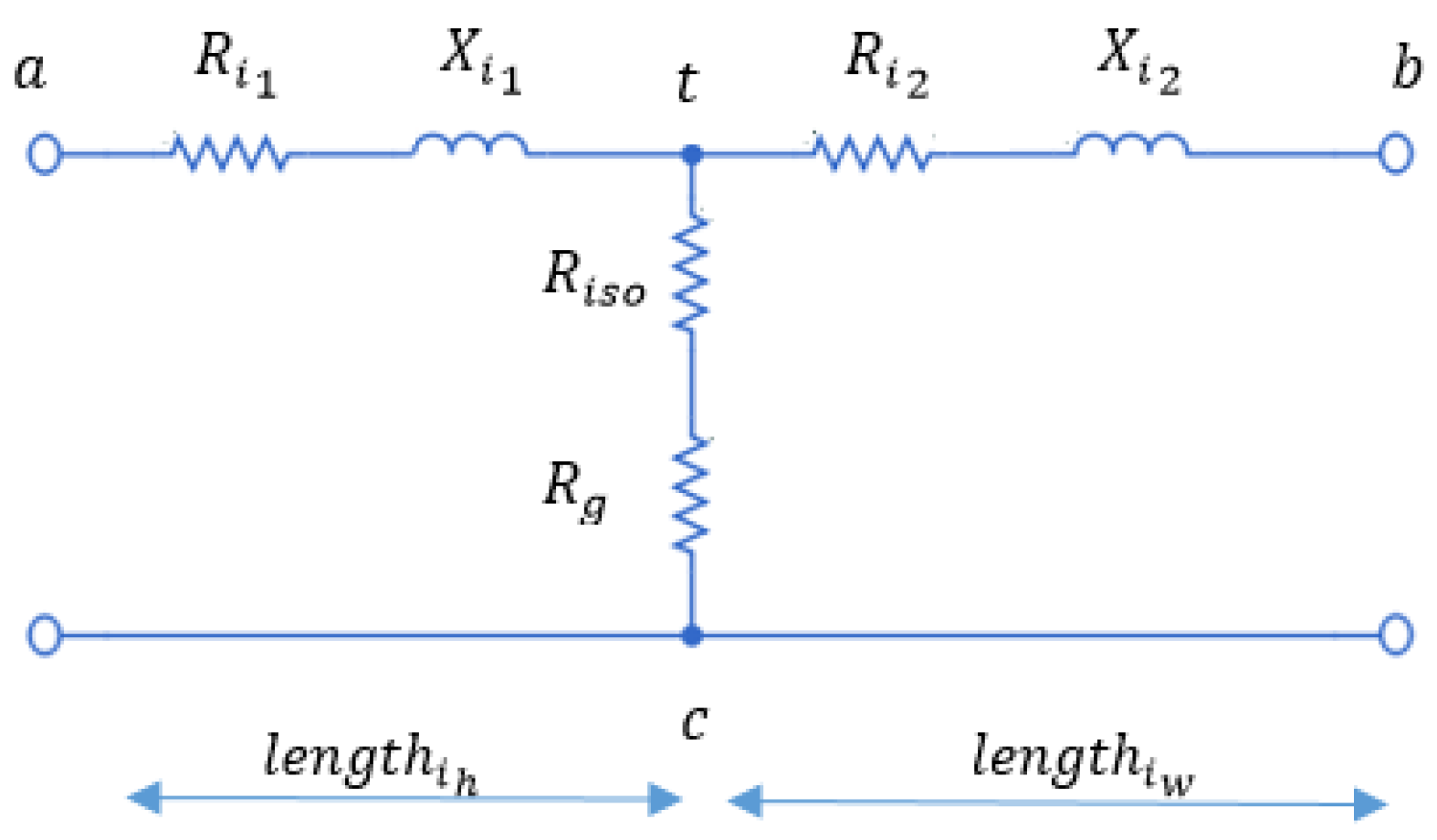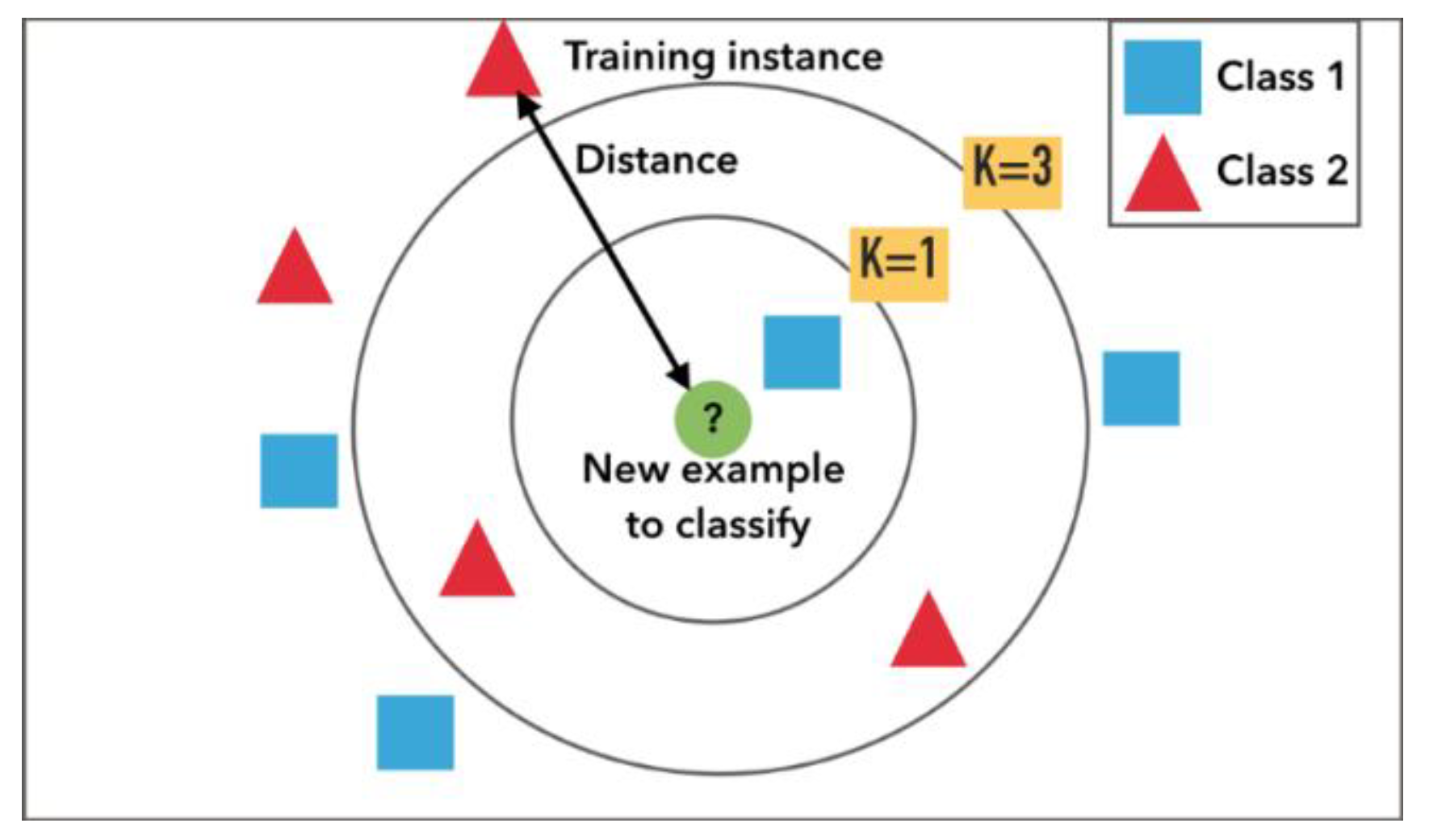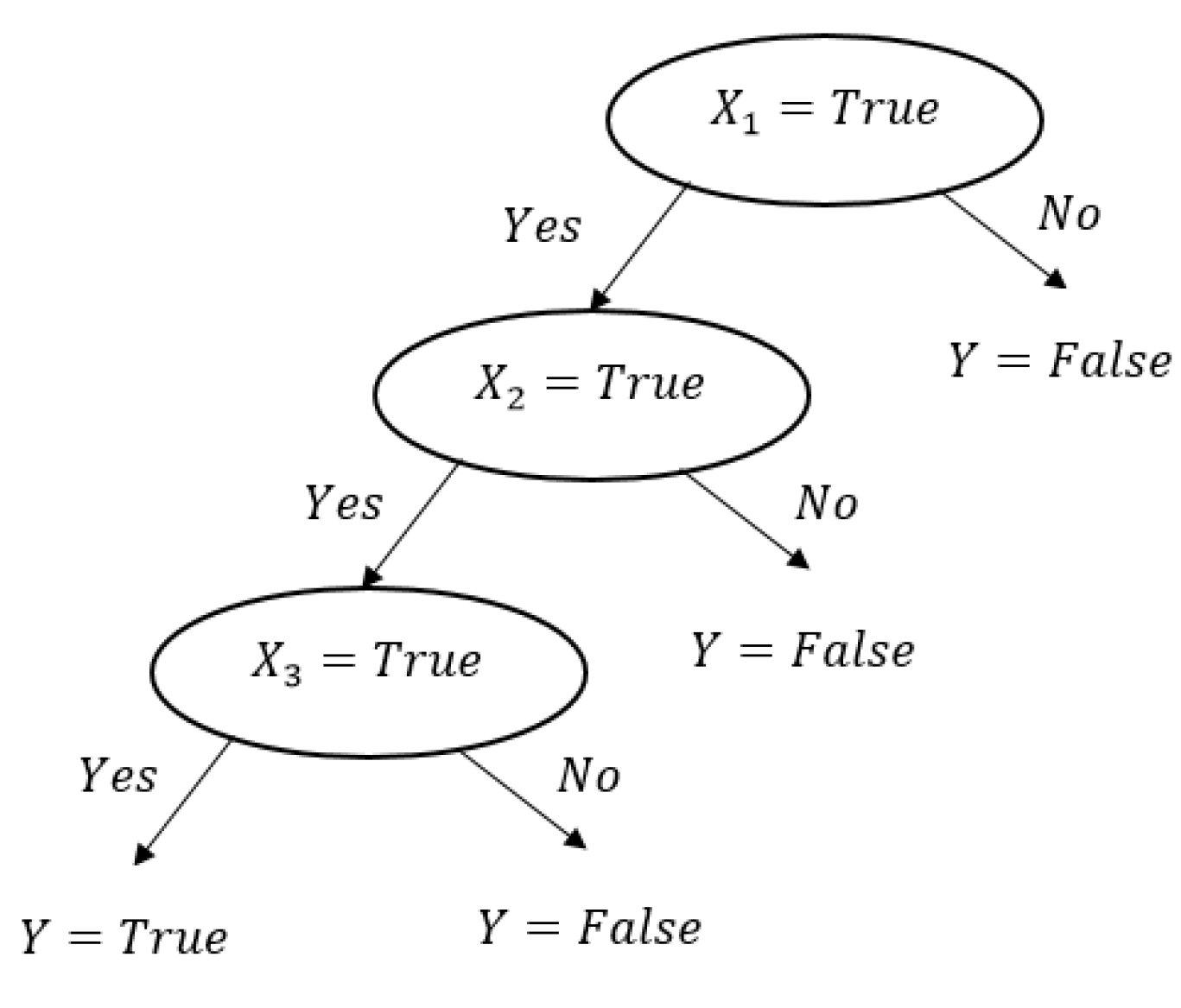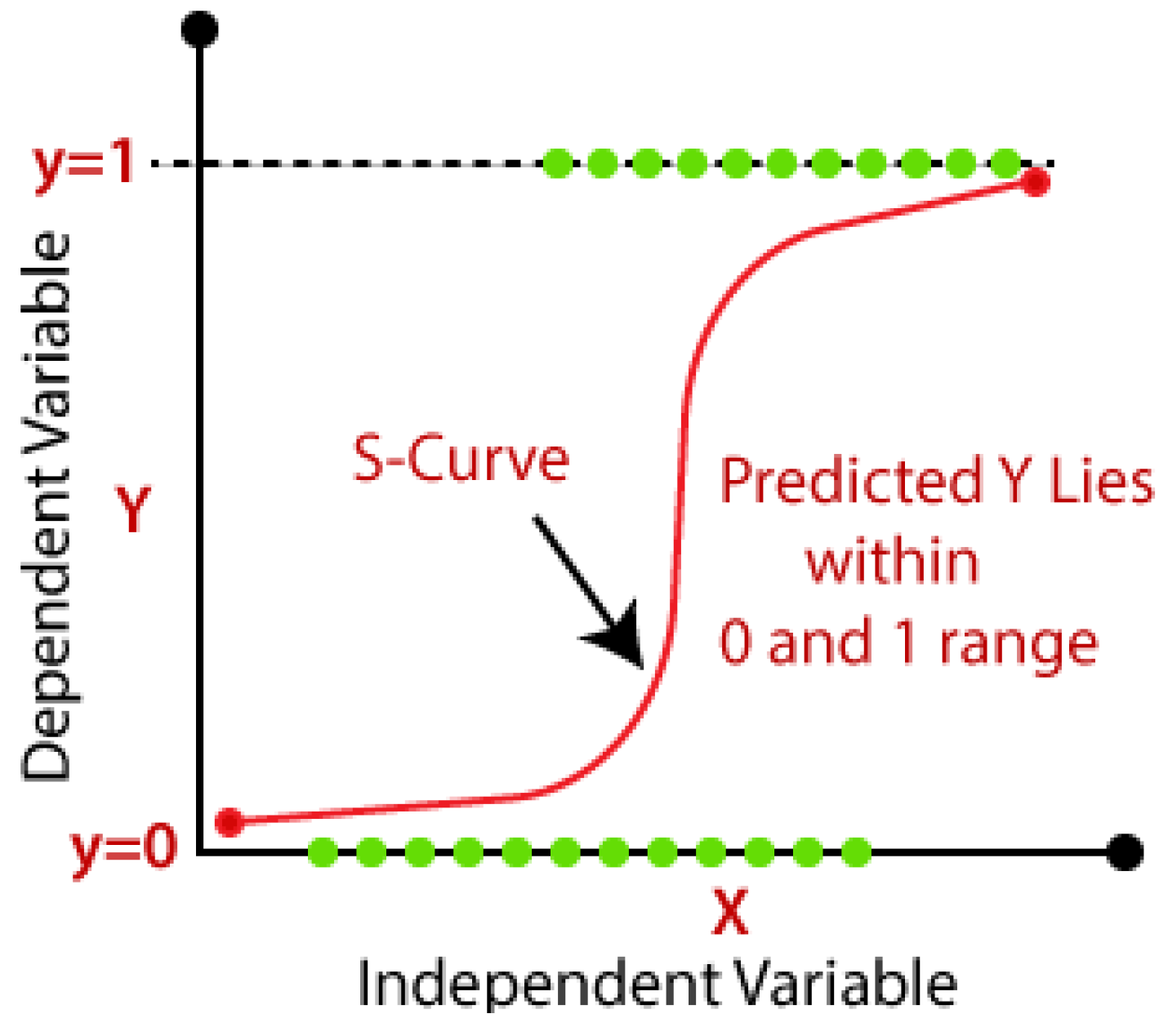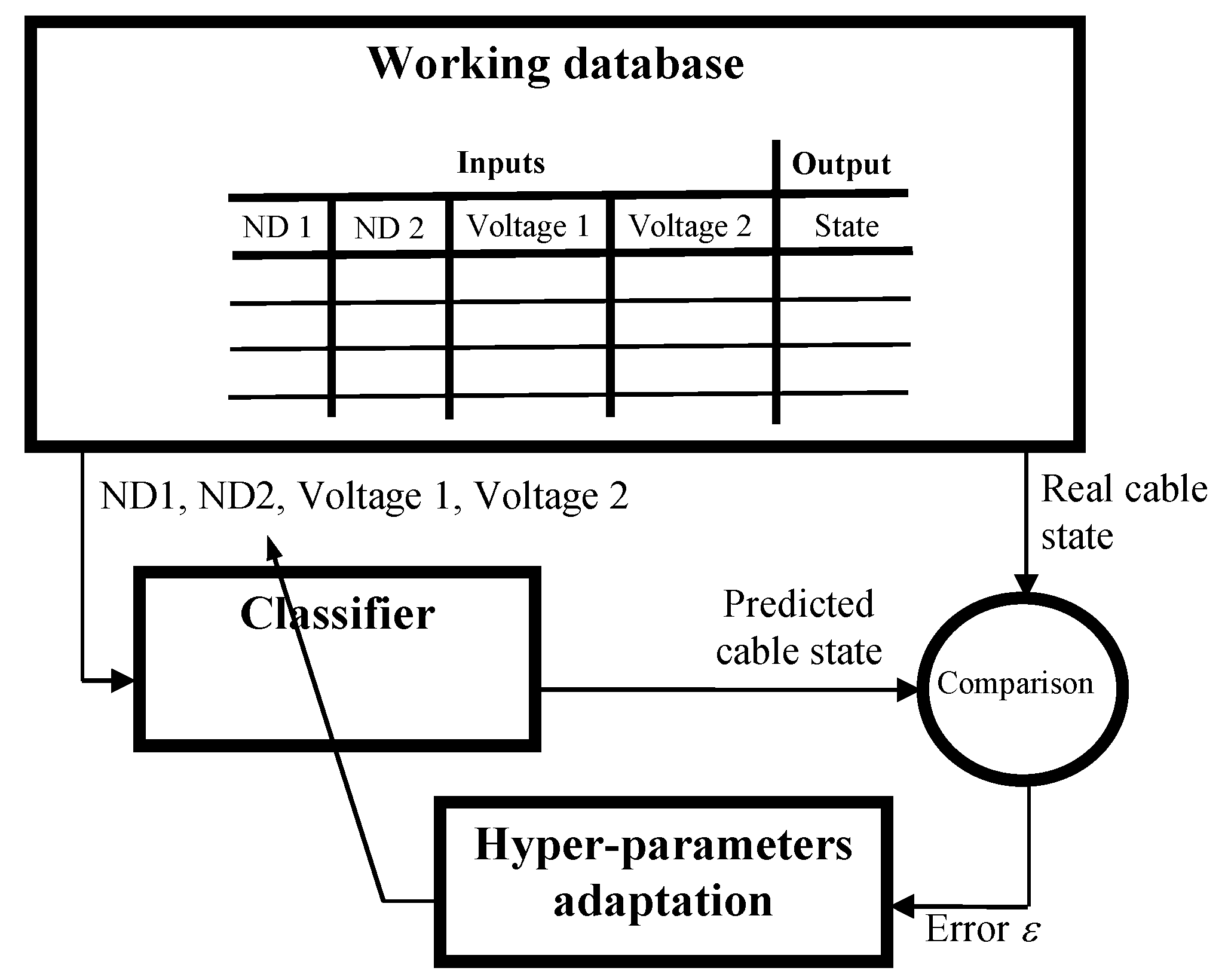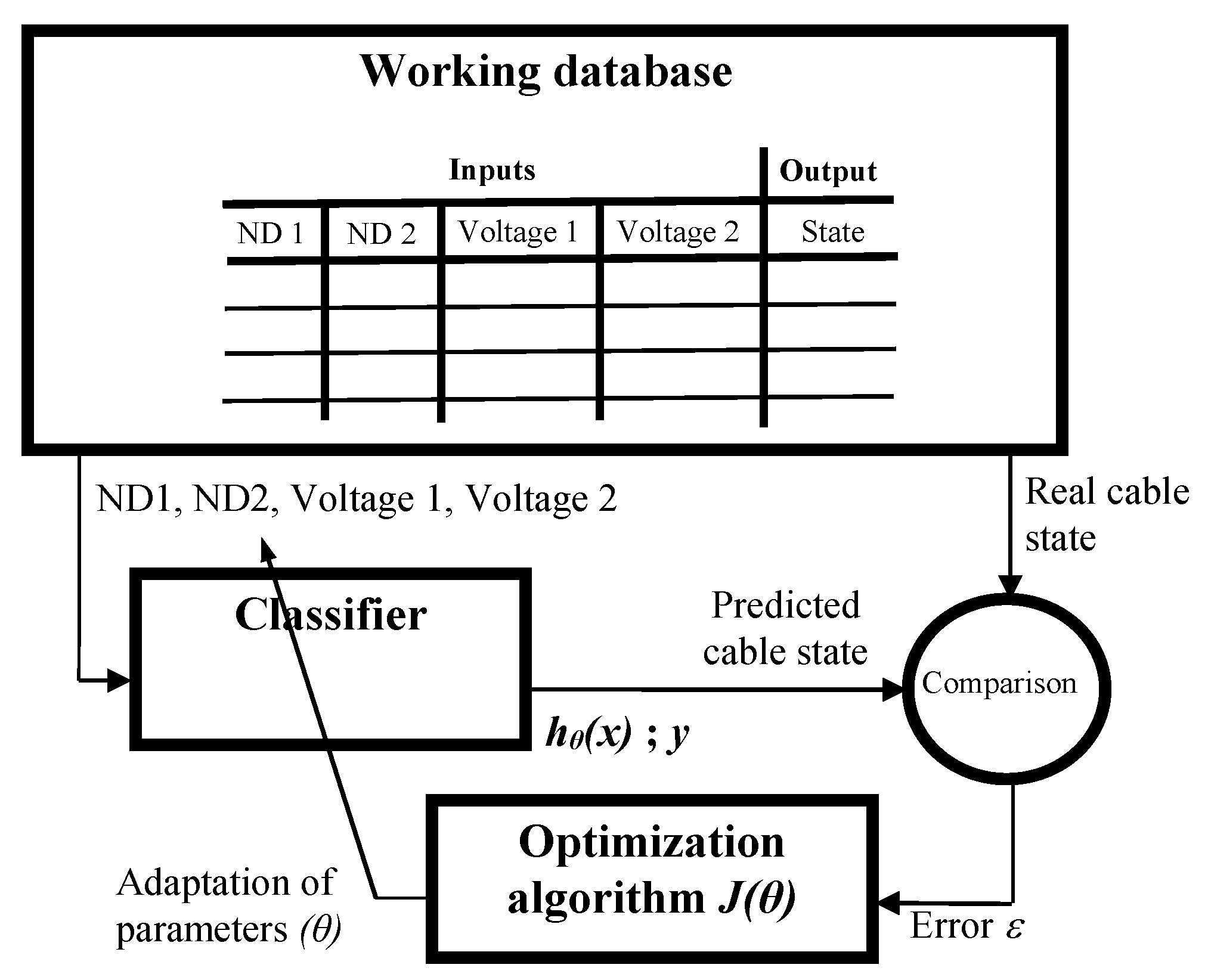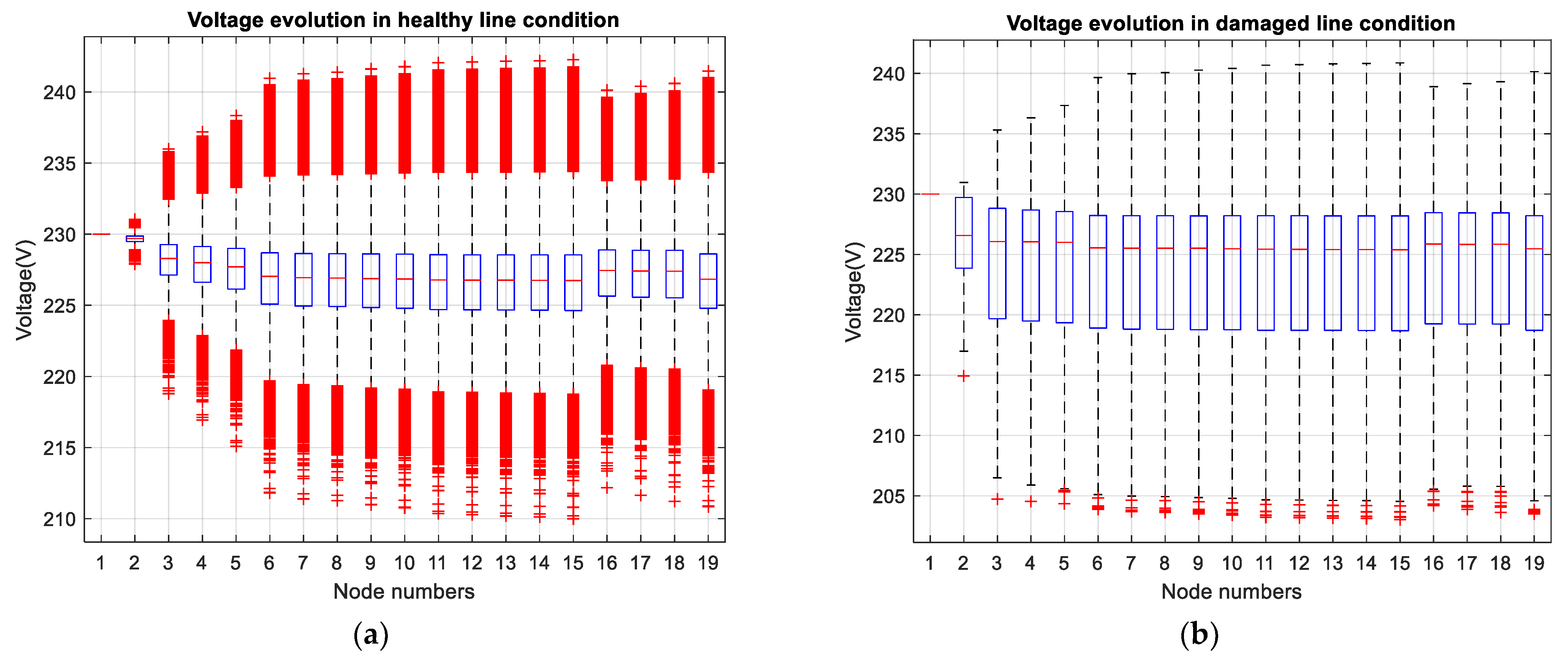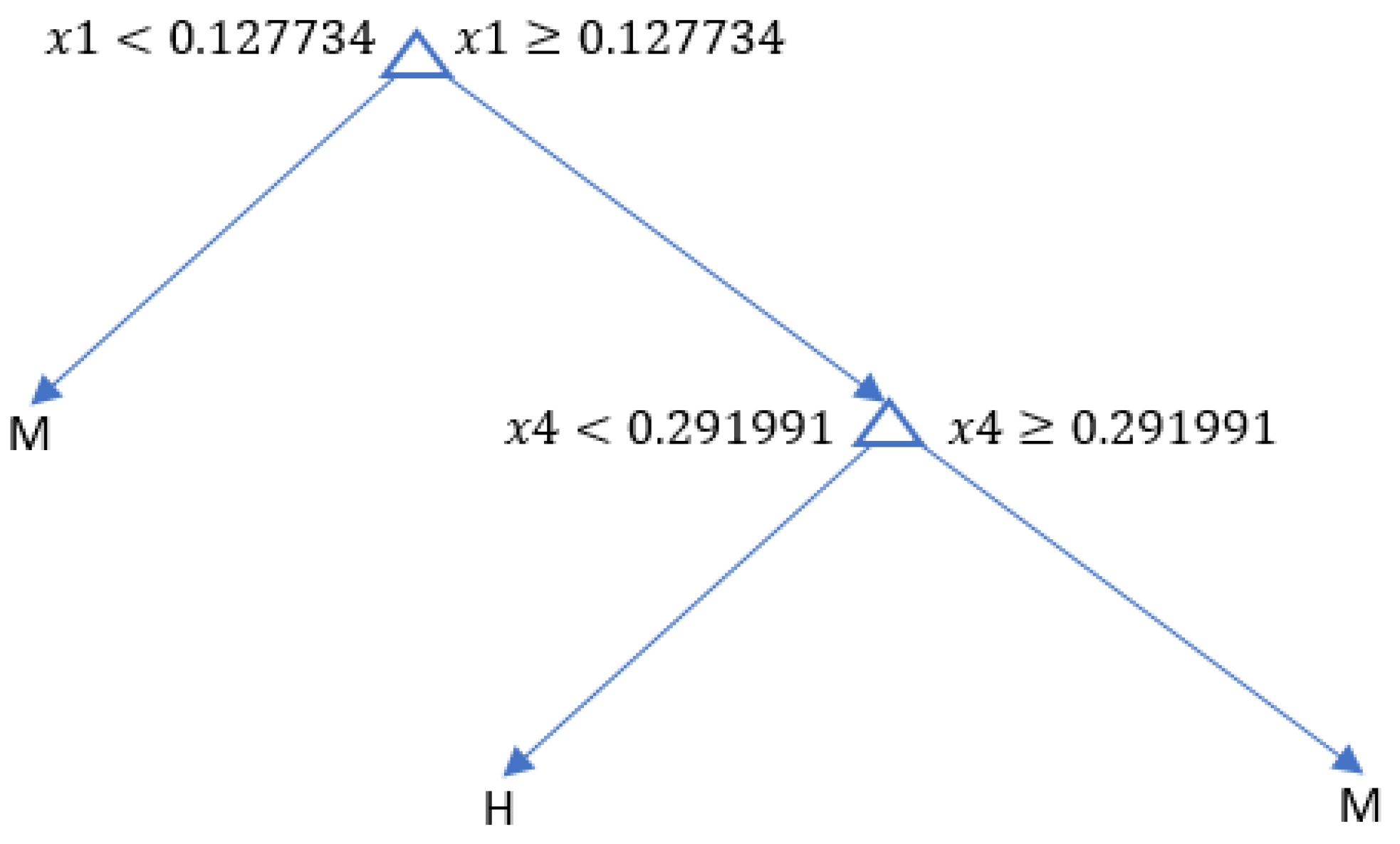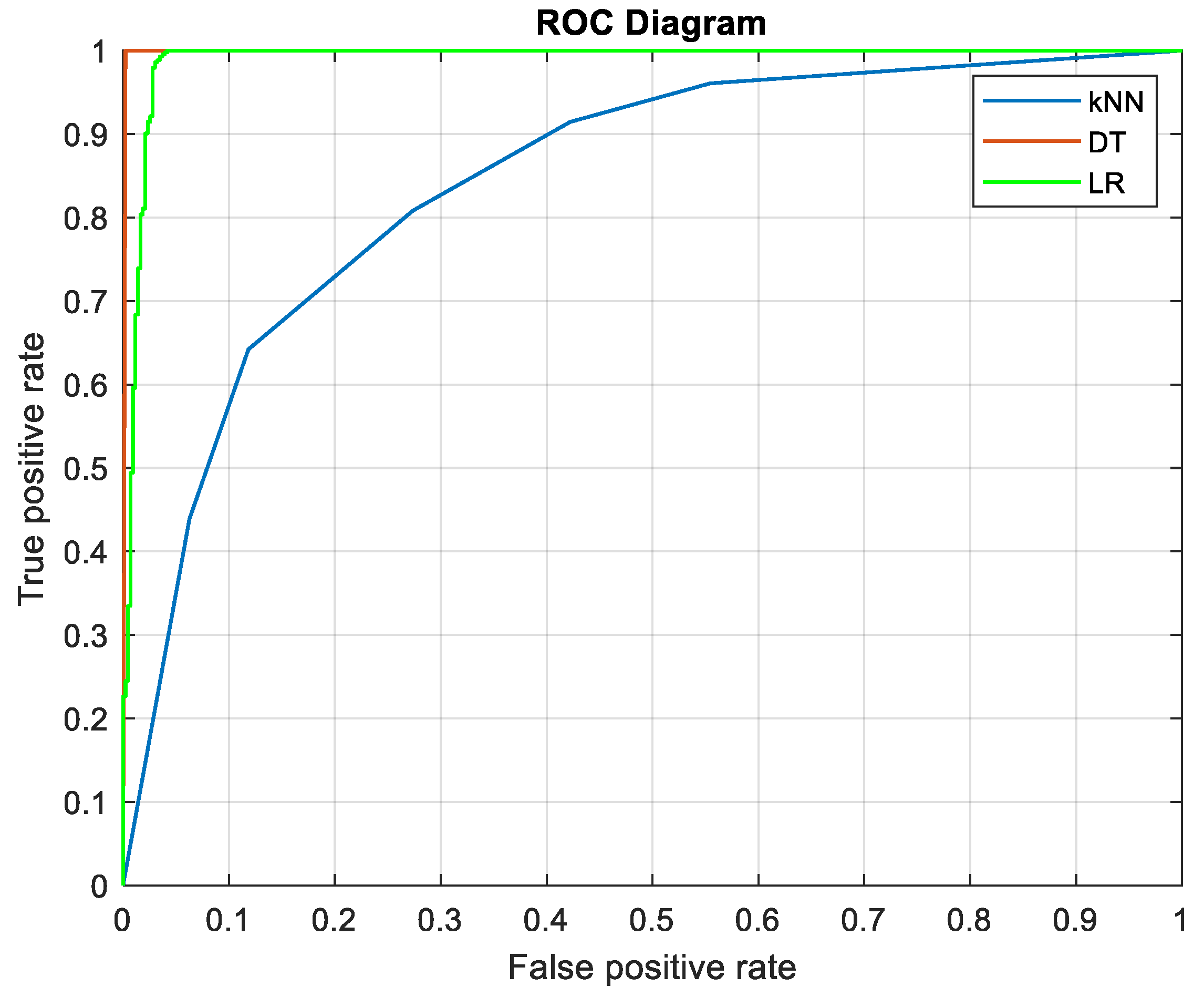1. Introduction
Electrical low voltage (LV) distribution networks are the last stage of the electrical power network, which supply many dispersed small-scale loads. A set of equipment such as MV-LV (medium voltage-low voltage) transformer substations, overhead/underground lines, protection systems, etc., compose those networks. The radial topology is widely used in LV distribution networks, with a voltage level around 230V. LV feeders are designed to feed a limited amount of end users in order to reduce the influence of an interruption. Consequently, either LV level interruption problems or LV equipment physical state problems (such as the cable ageing and deterioration) have received less attention.
The French standard NF C 15–100 (harmonized with the European standard HD 384) specifies that the insulating material of LV electrical cables must oppose the current all along the conductor [
1]. In fact, the deteriorations of the insulation material can increase the discharge of leakage currents, which can create overcurrent and voltage variation issues and can decrease the efficient operation and safety of the network. In addition, LV distribution networks (initially designed for unidirectional power flows) are currently subject to the bidirectional power flows and frequent voltage variations arisen from the extensive connection of decentralized photovoltaic (PV) generations. The voltage variation problems [
2,
3,
4] tend to increase the leakage current through the insulation material of LV cables. Monitoring the insulation material degradation then becomes a relevant issue.
Investigations have been carried out for modelling this insulation degradation through its resistivity variations. Additionally, the sensitivities of the insulation material to electrical and physical phenomena (such as stress in applied voltage) are analyzed. By studying the degradation of PVC (PVC (polyvinyl chloride)) insulated high-voltage cables, the author in [
5] has shown the impact of environmental conditions (phenomena such as temperature and humidity variations) on the ageing of this insulation material. In [
6], the authors developed a test procedure for electrical cable insulation material. The authors in [
7] have evaluated the insulation resistance characteristics of LV cable under extreme experiments (such as flame contact, over-current, and accelerated degradation). The studies in [
6,
7] reveal that the network external operating conditions directly affect the insulating properties of the material. They show that the insulation resistance value is doubly inversely proportional to a 10 °C temperature increase. Reference [
7] shows that accelerated degradation in the LV cable significantly reduces its equivalent life since it reduces the insulation resistance of the cable.
In the Netherlands, the research works [
8,
9,
10] investigated underground LV cables with a focus on jacket damage. Researchers in [
8] worked on how water ingress can progressively degrade the LV cable. To accomplish this, the experimental study was carried out based on two different plastic insulated cables (cross-linked poly-ethylene (XLPE) and PVC) artificially damaged by drilling an 8-mm hole into each cable. The cables have been tested in water exposure conditions and gradual degradation linked to partial discharges has been observed in the insulating material after any water evaporation phenomena. The different experiments showed that at a sufficient degree of degradation, breakdown can occur in the PVC cable (due to leakage currents) while the XLPE cable was still under operation. Indeed, the PVC, by decomposing, produces hydrogen chloride, which makes the water more conductive. In [
9], the same researchers made a comparative study of how polymeric insulation materials affect degradation growing in LV underground cables. That study pointed out the major role of the insulating material decomposition in the cable degradation rate, regarding its chemical composition. From this aspect, PVC material has led to significant degradation, unlike polyurethane (PU) and XLPE. In Hungary, references [
11,
12,
13] have studied the effects of distributed generation (DG) on the ageing and degradation of PVC insulation. Firstly, the work was focused on the thermal ageing of LV cables. Reference [
11], by implementing a periodic thermal ageing test, has shown an inverse correlation between hardness and the conductive properties of the cable. In [
13], the authors tracked the thermal aging of the PVC insulation material under various temperatures and different plasticizer contents. The results revealed the best PVC specimens for the monitoring and characterizing thermal aging in PVC insulated cables. However, these studies only focus on the physicochemical properties of the insulation material of cables.
Based on a diametrically opposed procedure, the study carried out in [
14] has explored the physical degradation of the cable through the sensitivity analysis of LV network voltage variation to various degrees of cable insulation wear. In that work, the position and degree of insulation degradation of the cable are modelled as uncertain variables. Then, a Monte Carlo (MC) analysis process was used to characterize unknown variables. MC techniques have been widely used in the literature to capture the uncertain and unobservable physical quantities in distribution systems.
Scenario creation processes based on the MC technique have proven their effectiveness either for uncertainty impact assessment associated with generated and consumed powers at each nodes of the network as in [
15,
16], or for characterizing the low voltage distribution systems (in a sensitivity analysis context), as in [
17]. Moreover, the uncertainty impacts associated to the electrical network parameters on the nodal voltages have been evaluated in [
18,
19]. Furthermore, reference [
20] investigated whether and when alternative maintenance strategies, using historical data, would be more profitable than the currently used corrective maintenance.
In a recent research direction, machine learning (ML) techniques have been studied for fault detection in [
21,
22,
23,
24,
25,
26,
27]. The study in [
22] addresses the benefit of a machine learning framework for fault detection and classification in power systems. By analyzing the most used ML techniques (within consideration of fault types and metrics for those techniques evaluation), the authors have shown the benefits of supervised classifiers to reliably solve power system problems. In the same way, a part of the research in [
23] was dedicated to the fault diagnosis in LV networks by using a deep neural networks approach. The results of this study allowed the authors to highlight the most influencing parameters in the fault assessment process, such as the fault resistance. In the context of grid monitoring, the authors in [
25] set up a power line modems (PLM)-based solution for the diagnostics of distribution network cable. By implemented various ML algorithms (combined with several preprocessing methods), the proposed approach ensures the employment of the best algorithm for a given diagnostic procedure. The work has been oriented through a two-stage approach from the degradation detection to the ageing and localized degradation assessment of XLPE-insulated cable. The key point of this approach relies on access to the PML database. The authors of [
27] investigated the role of ML in integrity analysis of subsea cables. From the design of a low frequency (LF) sonar system to the detection of the cable degradation stage through accelerated life cycle testing, their study provides a library of LF sonar responses depending on the cable types and conditions. Regarding voltage issues in the distribution network, the researchers in [
28] have worked on a centralized voltage control framework within consideration of the uncertainties related to the network working conditions and its physical parameters (dependency between temperature variation and line resistance; internal resistance of the transformer and consideration of the shunt admittances of power lines by using a PI line model). The authors have implemented a fast decision-making method, which is cost-efficient since the deep reinforcement learning-based agent can automatically adapt its behavior under varying operating conditions.
The above ML-based studies give relevant and acceptable accuracy results with a good speed and a low calculation burden. However, they do not integrate the assessment of the electrical properties of the LV network cables associated to its growing insulation degradation. It will therefore be interesting to investigate the integration of those ML tools in the LV cable condition assessment. Hence, this paper focuses on the implementation of a machine learning-based framework in order to identify the cable lines that present an insulation degradation, considering the voltage and net demand variation profiles of the distribution network.
The novelty of this study resides in its proposed machine learning-based framework to identify the cable insulation wear, relying on nodal voltage and load demand variations. Through the extensive analysis of cable insulation thickness variations and load flow calculations, a synthetic database is built. Then, the observations in the dataset are classified using several predictors whose impacts are studied. Indeed, the proposed work is a novel approach, which lies in the use of data from already largely deployed smart meters. From an economic point of view, it is a cost-effective approach compared to the actual costly monitoring of HV transmission lines where specific meters and communication systems are used (as implemented in France). In the LV distribution system, it is very expensive to deploy sensors and dedicated information and communication technologies in the entire electrical network. To tackle this challenge, this research project aims to take advantage of available data from smart meters and leverage the ML capabilities in order to detect the soft (early-stage) degradation of cable insulation (regardless of the type of fault). Despite the existing literature related to fault detection in electrical networks, the main contribution of the current study lies in its proposed methodology, where the problem has been approached through highlighting the relationships between the operating conditions of network, its nodal voltages and thickness variation of cable insulation.
The remaining of this paper is organized as follows:
Section 2 expresses the motivation and objectives of this study.
Section 3 and
Section 4 present the formulation of the insulation degradation problem and the way that the LV line is modelled in this work. In
Section 5, the proposed methods of classification are introduced. Then,
Section 6 presents the application cases, while
Section 7 discusses the obtained results. Finally, in
Section 8, the main conclusions are presented.
3. Characterization of the Cables Insulation Degradation
Electrical cables are subject to mechanical damage, excessive heat, ageing of material, and electrical stress on a daily basis. These operating conditions cause degradation of the cable insulation material, and in extreme cases, the cable can totally or partially lose its insulation. As consequence, the insulation impedance decreases, which generates a leakage current flowing through the cable to the ground. Therefore, this impedance is composed of the ground resistance as well as the resistance of the degraded cable insulation. The remainder of this section focuses on calculating the resistance associated to the degraded insulation.
In a degraded cable, the leakage current flows radially outwards from the center towards the surface of the cable along its length. So, let us assume a cylindrical cable that has a total radius
R, a length
L and a conductor radius equal to
r. The radius corresponding to the insulating material is equal to
R-r. Then, let us consider an elementary section of that cable with a radius
x and an insulation material thickness
dx (infinitesimally small layer of insulation) [
29]. The elementary cylindrical section (of area
2πLx) has an insulation resistance given by:
where
Riso-dx and
ρ are, respectively, the resistance and the resistivity coefficient of the insulation material.
From Equation (1), the insulation resistance of the cable is calculated by integrating the thickness value
dx over the radius of the insulating material [
14]:
The above equation gives a general formulation of an electrical cable insulation resistance. Then, by assuming that due to degradation the cable loses a part of its insulation thickness, the conductor radius r will remain constant while the cable radius R will reduce; radius variation will tend to decrease the insulation resistance value.
7. Results and Discussion
A first investigation is carried out to find the nodal voltage variation range of the feeder in a healthy cable condition (knowing that the maximum ND is associated to minimum voltage). The obtained values are limited to [210.19, 242.2734] Volts as shown in
Figure 13a. In addition,
Figure 13b presents the nodal voltages for moderately degraded cable located in the line between nodes 2 and 3. It should be noted that the extreme degradation scenarios as studied in [
6] have not been considered in this work. Moreover, the severe faults (extreme degradation scenarios) are easier to observe and detect. The interest in this study is focused more on the detection of the cable at the beginning of degradation process, which will be useful in managing cable maintenance and in anticipating the occurrence of severe faults or outage. Hence, the moderately degraded cable condition is linked to a soft fault degradation, which is not necessarily in breakage conditions but just introduces significant variations in the voltage profile.
In the boxplots of nodal voltage profiles shown in
Figure 13, the red positive signs demonstrate the outliers of the voltages in the created scenarios. The outliers in
Figure 13a are related to the prosumers ND demand variations while those in
Figure 13b are due to the nonlinear equation of the insulation conductance (1/Riso) applied in the NRLF computation. As it can be understood, the increase in insulation conductance (1/Riso) can lead to the voltage drops shown by the outliers.
Table 6 and
Table 7 show the prediction results obtained by the studied classification techniques in case 1 and case 2.
In
Table 6, it can be observed that LR and DT demonstrate good accuracies in the prediction process in case 1 (model trained with ND variations and nodal voltage profiles) while kNN performance is in a lower level. For the case 2, where the net demand (DT) is missing, it can be seen that the implemented algorithms lost performance. Therefore, the ND is an important predictor (input variable) for the classifier, as well as the voltage profiles. This is due to its unneglected impact on the nodal voltage variation range [
6]. The constructed tree for DT method is shown in
Figure 14 (corresponding to case 1). It reveals that normalized input ND profiles (named x1) will affect the prediction process as well as the normalized output voltage profile (named x4). As a result, the LR and DT lead to predictions with high accuracies in case 1.
Table 8 gives the related training and prediction accuracy for each studied classification method. By comparing these results, it can be concluded that the LR and decision tree are great binary classification tools, while the kNN method leads to less accurate predictions.
Figure 15 represents the confusion matrix of LR and DT methods for the first application case in order to visualize the quality of the classifiers output (see if the predictions really match the real associated classes for validating the prediction counts in
Table 6) in a three-dimensional plot. In
Figure 15, the axes yPred and yvalid correspond, respectively, to the outputs of the classifier (the predictions) and to the known cable conditions (real classes from the original dataset). Only a few damaged cable conditions could not be predicted with either LR or DT algorithms (small blue block corresponding to 30 observations in
Figure 15a and four observations in
Figure 15b).
Figure 16 shows the ROC (receiver operating characteristic) diagram representation of the prediction, which shows the ratio between the true positive (sensitivity) and the false positive (specificity) outputs of the classifier. It is the curved diagram of the classifier’s accuracy (in
Table 8). Knowing that the closer the curve is to a 45-degree diagonal of the ROC space, the less accurate the prediction result, it can be concluded that kNN is clearly the least efficient algorithm in the studied application case.
The conducted simulations on various degrees of insulation wear reveal interesting information about the added value of data-driven approaches for the cable condition assessment. Particularly, this work demonstrates the ability of different classification algorithms to identify, on the basis of only ND and voltage variation, the LV network cable condition assessment.
However, this presented work should not be directly extended for other practical applications or be generalized, for two reasons. Firstly, the resistance of the insulation material is calculated (in
Section 3) within consideration of some LV cable electrical properties specific to each manufacturer. Secondly, machine-learning techniques have been developed here for the degradation detection in operating domains where the causes of observed variations are difficult to interpret. Hence, to avoid a direct median separation in the observations, the input database has been built (in
Section 5.1) by excluding the cases of extreme degradation scenarios (severe faults) because they are easily detected without any advanced techniques.
8. Conclusions
In this study, a machine learning-based framework is proposed for the identification of low voltage cable degradation due to the insulation material wear. To this end, a probabilistic tool was first developed to generate scenarios for the uncertain nature and degree of the cable insulation degradation. Those scenarios were then associated with the load demand and PV generation variations and used to build the nodal voltage database by performing probabilistic load flow calculations. Different supervised learning methods were finally applied to the generated database. In the first (training) stage, the studied classification methods learned from the given inputs, its associated cable condition status in order to be able to predict, in the second (test) phase, the cable condition corresponding to each given network operating point. The comparisons between the implemented classifiers show that logistic regression and decision tree approaches are powerful binary classification tools with 97.917% and 99.884% accuracy performance, respectively, while the k-nearest neighbors method could not provide accurate predictions. The conducted study reveals the added value of such a data-driven approach for the cable condition assessment.
The interest of this work is to set up a tool that can assist the distribution system operators (DSOs) in an effective and timely predictive maintenance of the LV distribution network, avoiding the costly solutions. Indeed, the obtained result offers promising perspectives for the early detection of cable degradation by combining ML approaches, load demands profiles and smart meter (SM) measurements.
For future work, this research will extend the current model to a complete network, on the basis of cross nodal learning (learning between the models of each line section or cables in the network). The current study is the first step towards a global and generalized (e.g., by considering the type of cable as one of the classifier parameters) data-based early identification of electrical low voltage cable degradation due to insulation wear, using machine learning tools.
